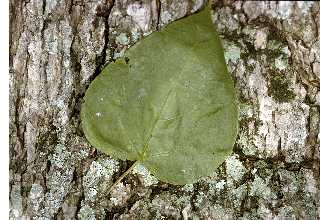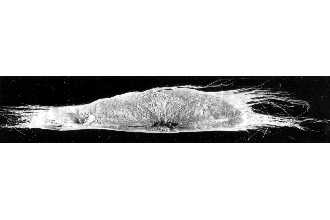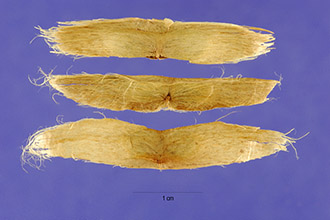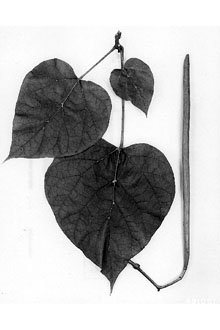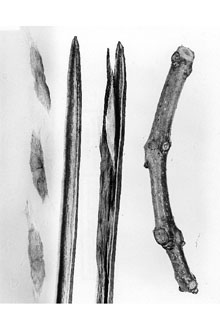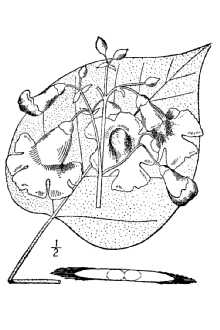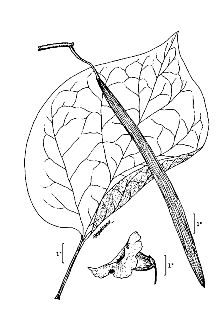Northern Catalpa
Scientific Name: Catalpa speciosa (Warder) Warder ex Engelm.
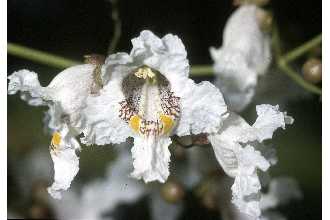
| General Information | |
|---|---|
| Usda Symbol | CASP8 |
| Group | Dicot |
| Life Cycle | Perennial |
| Growth Habits | Tree |
| Native Locations | CASP8 |
Plant Guide
Alternate Names
Hardy catalpa, western catalpa, Catawba, Catawba-tree, cigar tree, Indian bean tree, Indian cigar, Shawnee wood, early-flowering catalpa, Use soil moisture sensors to measure the soil moisture of Northern Catalpa., The name ‘catalpa’ comes from the Cherokee Indian language as the word for the tree, ‘Speciosa’ means “showy” for the large and numerous flowers,
Uses
Horticultural: Northern catalpa (Catalpa speciosa (Warder) Warder ex Engelm.) is primarily used today as a large ornamental shade tree. It is widely planted in urban areas as a street and lawn tree. When flowering, it has abundant showy blossoms. Conservation: Conservation uses include being planted in mined-land reclamation projects and shelterbelts. European settlers planted it to produce fence posts. The wood is lightweight, and the heartwood is resistant to deterioration when placed in the ground for several years. Railroad companies grew plantations of it for use as track ties and fuel wood. It was also used for making packing materials. Carpenters commonly used it for interior trim in houses. Craftsmen used it to make furniture. It has also been used as telephone or power line poles. Ethnobotany: In some of the older medical journals (19th century) there were speculations that catalpa gave off poisonous emanations. However, there is no scientific evidence to prove those speculations. Pioneer doctors used the seed pods and seeds to make a decoction for chronic bronchial affections, spasmodic asthma, labored breathing and heart problems. The juice from either the leaves or roots was used to treat swelling of an eye or cutaneous affections. Green leaves were crushed and placed on swollen lymph glands. The bark was dried then ground to a powder and taken, or brewed in a tea and taken for swollen lymph glands. Modern pharmaceutical research has shown catalpa trees have diuretic properties. It is sometimes planted to attract the green catalpa worms, which are prized fish bait. These caterpillars can be frozen and used as bait at a later time.
Status
Please consult the PLANTS Web site and your State Department of Natural Resources for this plant’s current status (e.g. threatened or endangered species, state noxious status, and wetland indicator values).
Weediness
This plant may become weedy or invasive in some regions or habitats and may displace desirable vegetation if not properly managed. Please consult with your local NRCS Field Office, Cooperative Extension Service office, or state natural resource or agriculture department regarding its status and use. Weed information is also available from the PLANTS Web site at plants.usda.gov.
Description
General: It is a perennial deciduous tree which readily grows in USDA Hardiness Zones 4 to 8. It has moderate to fast growth, tending to grow rapidly when juvenile, but slows with maturity. The height at 20 years is about 20 feet. The biggest northern catalpa recorded is in Indiana. It is 85 feet tall with a spread of 81 feet and a circumference of 290 inches at 4.5 feet above ground level. Catalpas prefer moist, deep, well drained soil, but adapts to dry or wet soils. The soil pH may range from 5.5 to 7.0. It prefers an open sunny space to partial shade. When it grows from seed the tree trunk rarely divides into two or more branches about the same size. If the tree is cut and grows back there is prolific spouting from the stump. The bole may be straight, but it is usually crooked. It is tall with an irregular, open-rounded to narrow-oval crown. This tree comes into leaf very late in the spring and it is one of the first to lose its leaves in the fall. Its longevity is about 60 years. The tree bark ranges from scaly to ridged, to blocky plates. On a mature tree trunk the bark may be from ¾ to 1 inch thick, light grayish brown in color, and broken into longitudinal, scaly, flat ridges. On young tree seedlings the bark is thin and easily damaged by impact, or rodents. Twigs in winter have a unique identifying characteristic. They have sunken leaf scars which resemble suction cups. Their whorled arrangement of 3 scars per node is another trait easily identified. Leaves are simple, large, ovate to ovate-oblong, from 8 to 12 inches long, are heart-shaped tropical looking without any lobes and are yellowish green in color. The leaf margins are entire, pointed at the tips and rounded to cordate at the bases. The top of the leaf is darker green than the underside which is also pubescent. Leaves are generally opposite on large branches and often whorled in 3 on young stems. Leaves may scorch and drop during droughts. They turn an undistinguished yellow in the fall before dropping. The leaves do not emit an unpleasant aroma when bruised as is the case with the southern catalpa (Catalpa bignonioides Walt.), which are also more abruptly pointed. The flowers of catalpa are perfect. Flowering takes place in late spring to early summer. They occur as large clusters of showy, white, bell-shaped corollas of 5 lobes with ruffled edges and yellow, orange or purple interior spotting or streaking. Individual flowers are showy, tubular up to ½ inch broad. They are branched in about 10 inch clusters at the stem tips. The northern catalpa flowers about 2 to 3 weeks earlier than the southern catalpa, which also has more spotted flowers. Flowers are good for honey production. Seedpods are slender and green in the summer growing from 10 to 24 inches long, looking similar to an exaggerated green bean. They mature in the fall, turn dark brown, split open lengthwise to let seeds fall in the spring. The whole pod is often blown off the tree. The shape and color of the mature seedpod gives rise to the common name of cigar tree. The southern catalpa seeds are drawn out more to a point while the northern catalpas seeds are blunter at the end. Seeds are about 1 inch long and 1/3 inch wide. They have a light brown coat and wings rounded at the ends terminating in a fringe of short hairs. There are approximately 20,480 seeds per pound. Seeds which are collected after overwintering in the mature seedpod have a higher germination rate than those collected in the fall and stored. The wood is of moderately light density (specific gravity 0.42 oven dry), with pale gray sapwood and grayish brown heartwood. It has a faint, aromatic, non characteristic odor and no characteristic taste. It is ring porous, coarse-grained, soft, not strong, but very durable in contact with the soil. Distribution: For current distribution, please consult the Plant Profile page for this species on the PLANTS Web site. Habitat: Prior to European settlement it was native to a small area of the central Mississippi Valley basin, western Tennessee, north east Arkansas, the lowlands of south east Mississippi and southern Illinois and Indiana. Farmers once planted catalpas in groves to provide shade for hog lots. It is now readily found from Kansas south to Texas and eastward to Louisiana.
Adaptation
It has been extensively propagated for over 200 years. It can now be found in most eastern states, and planted to some extent in Europe and New Zealand.
Establishment
When placed as an ornamental in a yard setting, care must be taken to ensure it is not too close to a building, fence, property line or septic system. Ample space should be provided to let it reach a mature height.
Management
The biggest management problem with a catalpa tree used as an ornamental is litter. It will drop a heavy load of flowers in the spring, then a plentiful supply of leaves in the fall and finally a lot of large seedpods in the winter.
Pests and Potential Problems
Larvae of the catalpa sphinx caterpillar (Ceratomia catalpae) eat the tree’s leaves. This causes significantly more nectar than normal to seep out of the damaged leaves. Almost complete defoliation may occur in some years. This increased nectar attracts various species of ants, ladybird beetles and a parasitoid. These predaceous insects attack and/or remove the eggs and young larvae of the catalpa sphinx. The secretion of extrafloral nectar and its subsequent harvesting by insects is mutually beneficial to both the catalpa tree and the predaceous insects. Rabbits are especially damaging in their girdling of young stems. Immature seeds in the pods are often destroyed by a small yellow grub, the larva of a gnat. Catalpa midge (Cecidomyia catalpae Comstock) causes leaf spots, injures terminal buds and branch tips, as well as seeds in the pods. Brown leaf spots on leaves are often created by the fungi Macrosporium catalpae. This is rarely a serious problem so no chemical treatment is recommended. Catalpa is also susceptible to the decay fungus Polystictus versicolor. It can severely damage catalpa trees after about 20 years of age in the western part of its planted range. Powdery mildew causes a white powdery coating on the leaves. When severe the leaves turn yellow and drop. Verticillum wilt will make the branches die, and can eventually kill trees. A hard to find symptom of verticillum wilt is discoloration of the sapwood.
Environmental Concerns
Concerns
Concerns
It is an invasive, weedy tree which escapes cultivation easily. The flowers, long seedpods and seeds fall down from spring through winter, and create a mess on the ground anywhere near the tree. Its brittle wood makes its branches subject to wind and ice damage.
Seeds and Plant Production
Plant Production
Plant Production
Catalpas can readily be grown from seed. Research shows seeds collected after overwintering in the seedpods had better germination than those collected in the fall and stored inside. Root cuttings may also be used to propagate trees. Cultivars, Improved, and Selected Materials (and area of origin) There are two species of catalpa native to North America, northern catalpa (Catalpa speciosa) and southern catalpa (Catalpa bignonioides). They appear very similar but are two distinct species. One variety of C. speciosa has been documented: pulverulenta from Paul & Son. Contact your local Natural Resources
Conservation
Service (formerly Soil Conservation Service) office for more information. Look in the phone book under ”United States Government.” The Natural Resources Conservation Service will be listed under the subheading “Department of Agriculture.”
Control
Please contact your local agricultural extension specialist or county weed specialist to learn what works best in your area and how to use it safely. Always read label and safety instructions for each control method. Trade names and control measures appear in this document only to provide specific information. USDA, NRCS does not guarantee or warranty the products and control methods named, and other products may be equally effective.
Fact Sheet
Alternate Names
Hardy catalpa, western catalpa, Catawba, cigar tree, Indian bean tree, Indian cigar
Uses
Northern catalpa is primarily used today as a large ornamental shade tree. It is widely planted in urban areas as a street and lawn tree. Conservation uses include plantings in mined-land reclamation projects and shelterbelts.
Status
Please consult the PLANTS Web site and your State Department of Natural Resources for this plant’s current status (e.g. threatened or endangered species, state noxious status, and wetland indicator values).
Weediness
This plant may become weedy or invasive in some regions or habitats and may displace desirable vegetation if not properly managed. Please consult with your local NRCS Field Office, Cooperative Extension Service office, or state natural resource or agriculture department regarding its status and use. Weed information is also available from the PLANTS Web site at plants.usda.gov.
Description and Adaptation
Adaptation
Adaptation
A member of the Trumpet-creeper Family (Bignoniaceae), northern catalpa is a perennial deciduous tree which readily grows in USDA Hardiness Zones 4 to 8, The height at 20 years is about 20 feet, Catalpas prefer moist, deep, well drained soil, but adapts to dry or wet soils, The soil pH may range from 5,5 to 7,0, It prefers an open sunny space to partial shade, It is tall with an irregular, open-rounded to narrow-oval crown, This tree comes into leaf very late in the spring and it is one of the first to lose its leaves in the fall, Its longevity is about 60 years, The tree bark ranges from scaly to ridged, to blocky plates, On young tree seedlings the bark is thin and easily damaged by impact, or rodents, Twigs in winter have a unique identifying characteristic, They have sunken leaf scars which resemble suction cups, Use soil moisture sensors to measure the soil moisture of Northern Catalpa., Their whorled arrangement of 3 scars per node is another trait easily identified, Leaves are simple, large ovate to ovate-oblong, from 8 to 12 inches long, heart-shaped tropical looking without any lobes and are yellowish green in color, Leaves are generally opposite on large branches and often whorled in 3 on young stems, They turn an undistinguished yellow in the fall before dropping, The flowers of catalpa are perfect, Flowering takes place in late spring to early summer, They occur as large clusters of showy, white, bell-shaped corollas of 5 lobes with ruffled edges and yellow, orange or purple interior spotting or streaking, Individual flowers are showy, tubular up to ½ inch broad, They are branched in about 10 inch clusters at the stem tips, Seedpods are slender and green in the summer growing from 10 to 24 inches long, looking similar to an exaggerated green bean, They mature in the fall, turn dark brown, split open lengthwise to let seeds fall in the spring, The shape and color of the mature seedpod gives rise to the common name of cigar tree, It has been extensively propagated for over 200 years, It can now be found in most states east of the Rocky Mountains and in Utah,
Establishment
When placed as an ornamental in a yard setting, care must be taken to ensure it is not too close to a building, fence, property line or septic system. Ample space should be provided to let it reach a mature height.
Management
The biggest management problem with a catalpa tree used as an ornamental is litter. It will drop a heavy load of flowers in the spring, then a plentiful supply of leaves in the fall and finally a lot of large seedpods in the winter.
Pests and Potential Problems
Larva of the catalpa sphinx caterpillar (Ceratomia catalpae) eats leaves. Almost complete defoliation may occur in some years. Immature seeds in the pods are often destroyed by a small yellow grub, the larva of a gnat. Brown leaf spots on leaves are often created by the fungi Macrosporium catalpae. Catalpa is also susceptible to the decay fungus Polystictus versicolor. Powdery mildew causes a white powdery coating on the leaves. When severe the leaves turn yellow and drop. Verticillum wilt will make the branches die, and can eventually kill trees. Catalpa midge (Cecidomyia catalpae Comstock) causes leaf spots, injures terminal buds and branch tips, as well as seeds in the pods.
Environmental Concerns
It is an invasive, weedy tree which escapes cultivation easily. The flowers, long seedpods and seeds fall down from spring through winter, and create a mess on the ground anywhere near the tree. Cultivars, Improved, and Selected Materials (and area of origin) There are two species of catalpa native to North America, northern catalpa (Catalpa speciosa) and southern catalpa (Catalpa bignonioides). They appear very similar but are two distinct species. One variety of C. speciosa has been documented: ‘Pulverulenta’ from Paul & Son.
Plant Traits
Growth Requirements
| Temperature, Minimum (°F) | -38 |
|---|---|
| Adapted to Coarse Textured Soils | Yes |
| Adapted to Fine Textured Soils | No |
| Adapted to Medium Textured Soils | Yes |
| Anaerobic Tolerance | None |
| CaCO3 Tolerance | Low |
| Cold Stratification Required | No |
| Drought Tolerance | Medium |
| Fertility Requirement | Medium |
| Fire Tolerance | None |
| Frost Free Days, Minimum | 90 |
| Hedge Tolerance | None |
| Moisture Use | Low |
| pH, Maximum | 7.0 |
| pH, Minimum | 5.5 |
| Planting Density per Acre, Maxim | 1200 |
| Planting Density per Acre, Minim | 100 |
| Precipitation, Maximum | 80 |
| Precipitation, Minimum | 20 |
| Root Depth, Minimum (inches) | 20 |
| Salinity Tolerance | Low |
| Shade Tolerance | Intolerant |
Morphology/Physiology
| Bloat | None |
|---|---|
| Toxicity | None |
| Resprout Ability | Yes |
| Shape and Orientation | Erect |
| Active Growth Period | Spring |
| C:N Ratio | High |
| Coppice Potential | No |
| Fall Conspicuous | Yes |
| Fire Resistant | No |
| Flower Color | White |
| Flower Conspicuous | Yes |
| Foliage Color | Dark Green |
| Foliage Porosity Summer | Dense |
| Foliage Porosity Winter | Porous |
| Foliage Texture | Medium |
| Fruit/Seed Conspicuous | Yes |
| Nitrogen Fixation | Low |
| Low Growing Grass | No |
| Lifespan | Long |
| Leaf Retention | No |
| Known Allelopath | No |
| Height, Mature (feet) | 60.0 |
| Height at 20 Years, Maximum (fee | 20 |
| Growth Rate | Rapid |
| Growth Form | Single Stem |
| Fruit/Seed Color | Brown |
Reproduction
| Vegetative Spread Rate | Slow |
|---|---|
| Small Grain | No |
| Seedling Vigor | Medium |
| Seed Spread Rate | Slow |
| Seed per Pound | 20480 |
| Fruit/Seed Persistence | Yes |
| Propagated by Tubers | No |
| Propagated by Sprigs | No |
| Propagated by Sod | No |
| Propagated by Seed | Yes |
| Propagated by Corm | No |
| Propagated by Cuttings | No |
| Bloom Period | Early Summer |
| Commercial Availability | Routinely Available |
| Fruit/Seed Abundance | Medium |
| Fruit/Seed Period Begin | Fall |
| Fruit/Seed Period End | Fall |
| Propagated by Bare Root | Yes |
| Propagated by Bulb | No |
| Propagated by Container | Yes |
Suitability/Use
| Veneer Product | No |
|---|---|
| Pulpwood Product | Yes |
| Protein Potential | Low |
| Post Product | Yes |
| Palatable Human | No |
| Palatable Graze Animal | Low |
| Palatable Browse Animal | Low |
| Nursery Stock Product | Yes |
| Naval Store Product | No |
| Lumber Product | Yes |
| Fuelwood Product | High |
| Fodder Product | No |
| Christmas Tree Product | No |
| Berry/Nut/Seed Product | No |

